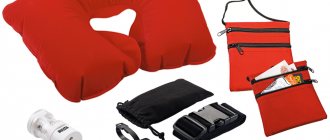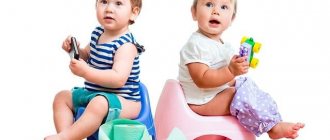Velvet season with a child
Don't miss the moment for the whole family to enjoy the joys of a bright and warm autumn at a seaside resort.
Anastasia Melentyeva
Read more
I have compiled a list of working and proven tips from parents who already have their own positive experience of flying with children from six months to 4 years old, as well as the experience of children’s doctors and airline employees. Now is the height of holidays and holidays, which means it’s time to remind you of these simple but very necessary recommendations.
Psychological preparation of yourself
“The issue of a screaming child is a matter of preparing the accompanying parent.”
Prepare in advance for the fact that everything will be bad: the child will cry, and the neighbors will be unloving and scandalous. Particularly sensitive parents are better off drinking a sedative (not to be confused with vodka) in advance, so as not to fall into hysterics themselves. Calm parents mean a calm child. The calmer the parents, the easier it is for the children. Even if you have conflicts in your family, conclude a peace agreement in advance for the duration of all flights with your child. Agree to immediately make peace with any quarrel, no matter who is to blame. You can do it childishly by shaking each other’s little fingers. Your swearing will certainly plunge the child into depression, he will also start crying, and this will make it worse for you, for him, and for everyone around him. Dads who are used to flying without children and drinking alcohol need to immediately understand that they will have to give up this habit and take full care of the child (either alone or with the mother). There should not be a situation where the mother cannot calm the child, and the father drinks and watches a movie.
Basic rules of behavior on the train:
- Do not let your child out of your sight, especially during stops. The baby loves to learn something new, and the guide will not always notice that the baby has gone out unaccompanied. Tell us in advance how to act in such a situation (teenagers who did not have time to return from the store or station will also need it) - stay in place, contact the duty officer. Then he and the leaders will find the best way out of the situation.
- Do not allow yourself to raise (lower) the shelves; watch when the baby climbs up.
- Do not put things in other people’s places; remove toys and table surfaces from paint or plasticine residues in a timely manner.
- Since it is not always possible to predict the temperature in the carriage, have warm and light clothing just in case.
Psychological preparation of the child
On the eve of the very first flight (if the child is already able to understand what it is about), it would not hurt to tell him what an airplane is, how it hums, how many people are around and how interesting and easy it is to play in it. It is advisable to do everything so that the child already dreams of flying and looks forward to it like a birthday or New Year. Some parents recommend allowing many things on board that they forbid in ordinary children’s lives: “For them, this is a kind of holiday, because only on the plane can they drink cola and suck candy. I don’t allow them to do that at home.”
The same goes for computer games: if at home it is strictly limited in time, then on the plane there is freedom, as long as the child is captivated by the game longer. In general, the plane is such a zone of controlled disobedience and a complete holiday.
Affordable in-flight entertainment
You won't be able to take all your favorite toys on board the plane. First, there are serious security requirements. It is not allowed to carry liquid, bulky or sharp objects with you. Secondly, the number of things is limited to hand luggage.
But there is a way out of trouble. To capture a child's attention for 2-4 hours, take:
- Small books of A5 format and smaller: fairy tales, alphabet books, products with three-dimensional illustrations, and the like. For the youngest travelers, choose bright drawings that can be studied for a long time. For preschoolers, you can grab a book with an interesting plot, but a minimum of text - they will quickly get tired of reading.
- Creative equipment that can be brought on board: plasticine, salt dough, paper, pencils, felt-tip pens. A folding table on the seat opposite is suitable as a stand.
- Small toys. There are many of them, they take up little space, and they will interest the child for a long time if you offer to act out plots, imagine a city of animals, invent characters and their personalities.
- Finger games with jokes, playing with palms , etc. Study interesting rhymes and riddles to have a backup option. You can play quizzes and truth/false games with preschoolers.
Keep “surprises” secret so as not to replay all the games in one hour.
Selecting an airline, seats, flight, time
Many reputable airlines help parents turn the flight into a holiday : they give out kits with a toy, coloring book, and pencils. In addition, there are monitors in the backs of Airbus seats on which you can watch cartoons, films, play toys, etc. (I recently flew on such an airbus from Barcelona to Moscow: it was all there).
True, good airlines are not affordable for everyone. And if you fly through a travel agency, then you can run into such a charter that even adults will cry. However, everything that is distributed to children on board can be taken from home. At the same time, you will more accurately guess what exactly your baby needs - airlines still have an average set. However, there will be a separate section about toys and treats. An important role is played by the availability of children's places and the ability to book them. Many airplanes have folding or hanging bassinets for infants. A hanging cradle (even if the child will not sleep in it, you can put the baby there for a while to feed yourself or just give your arms and legs a rest), a space in front of the seats where the child can frolic without disturbing the passengers sitting in front, in the same place, in the end, you can put a children's potty.
To book such seats, when purchasing tickets, you need to check whether they are available and whether a bassinet is provided during the flight. The office staff of the selected airline will provide such information. After purchasing tickets, you need to immediately book these seats - sometimes this can be done directly on the airline’s website, sometimes by contacting its employees. And a few days before departure, call back and confirm. If the airline does not provide the ability to reserve such seats, you will have to go to the airport in advance to be one of the first to be at the check-in counter. And here’s another important thing: if you are flying with a stroller and with transfers, you must indicate when registering where you would like to receive it.
Most non-breastfed children prefer to sit by the window and watch what is down there. In addition, it is more comfortable to sleep by the window and the child certainly does not risk getting hit in the leg or arm with a cart. So try to book at least one window seat. As for the choice of flight and time, opinions differed. Some argue that it is better to take tickets for flights that minimally change the child’s daily routine, and try to maintain it during the flight. Others advise getting your child up early or not letting you sleep at all before the flight. “To exhaust the child before the plane so that he falls asleep on the plane.” Another option: “We choose early flights when the rise occurs at one or two in the morning. The child sleeps most of the flight.”
However, this is not suitable for all children: “But lack of sleep can have a different effect on us. The last time the child cried for half an hour that he didn’t want to sleep on the plane, but wanted to go to bed, although he was already dying and wanted to sleep.” In general, here rely on your own experience and your own child, but in general the “exhaust” method works for most children. Especially if they are given sleeping pills or a sedative before departure. There was also advice not to fly long distances with a connection in one sitting: “We fly from Moscow to the States and always sleep the night at the Amsterdam airport - this greatly reduces the number of hysterics. A well-rested and well-fed child is already 50% of success.”
Is there an alternative?
For example, some kids get tired from changes in blood pressure, a long journey to the airport, or waiting, so they can sleep for an hour or two.
Long flights are a time to explore space. In addition, this will calm a child who is flying for the first time and is nervous. After takeoff, walk around the cabin with your child, show where the toilet is (for preschoolers), explain why flight attendants, belts, and shelves are needed.
This way you will gain valuable time, because the excursion will last at least half an hour. The child will adapt to the new environment and will calm down, because he will see that mom and dad are calm. Perhaps you will meet other children and make new acquaintances.
Entertainment on your tablet or phone. But we do not recommend using this option and keeping your child busy with gadgets throughout the flight. And if the flight is long and parents also want to relax, then you can invite the child to play games or watch cartoons.
Remember that the aircraft cabin is a public place. Try not to interfere with other passengers' rest. And also take care of the safety rules: fasten your seat belts, follow all the instructions of the flight attendants, keep an eye on your child, and do not enter the service premises. During turbulence, remain calm.
Immediately put the oxygen mask on yourself first, then on your children.
Photo: rastorjeniebraka
Experienced travelers also advise taking care of comfortable clothes: a T-shirt, a long-sleeve sweater, trousers or jeans. Bring something warm for the children, as there is air conditioning on board. Shoes should be comfortable in size and sporty. During long flights you will need special socks (to prevent your feet from swelling) and a pillow. Blankets are usually provided upon request.
What to take with you
• For a very young child : diapers, wet wipes, water in a bottle with a sippy cup, dryers, new books with engines and a couple of old favorites, three new small cars in mom’s pocket (take out in critical situations), a change of clothes;
• 1-2 years : potty, wet wipes (wipe your hands often), water, dryers, books, cars, a couple of toys, a change of clothes, patience for mom and dad to walk around the airplane cabin. Children at this age always want to go out and see everything;
• 3-4 years : potty, napkins, water, dryers, clothes, favorite books, puzzles, construction sets, magazines with stickers, puzzles.;
• 5-6 years : napkins, magazines with labyrinths, stickers, scanwords, Legos, cards, dominoes, backgammon, checkers, etc.;
“Bring a change of clothes for the child and mother. It’s not so rare that a child, especially under 2 years old, who sits in his mother’s arms, gets wet himself and doesn’t forget his mother.”
Also, a few apples cut into slices, medications for motion sickness, pain, and sedatives are always useful. “I also always take a couple of shawls/scarves with me - firstly, you can save the child from the cold, and secondly, it’s like dressing up (I have a classic girl).” And of course, a great toy is a dad’s/mom’s smartphone if you are sure that the child won’t erase anything on it.
Before going on the road, explain the rules of conduct:
- You cannot open doors while the car is moving or a window without permission, or lean out of it.
- Do not touch the dashboard, levers, handbrake.
- Children under 145 cm tall (under 12 years of age cannot ride in the front seat). Babies are picked up and placed in a cradle to sleep. Older children are carried in a special child seat with their own seat belts. No matter how much your child asks you to ride in front a little, don’t let him, think about his safety in an emergency.
- If your baby is tired or wants to go to the toilet, stop. This will stretch the route a little, but the child still needs to move. Avoid traveling at night; it is better to spend the night in a hotel.
- Don't let the driver be distracted from the road. He doesn't participate in fun because he has to be focused.
- In case of delays on the road, have snacks, pillows for naps, comfortable clothes and a warm blanket.
What to do with your child during a flight
“If a child is nervous in a separate seat during takeoff, you need to ask the flight attendant for a child’s belt, sit him on the lap (not the flight attendant, but the child) and fasten it to you.”
“During takeoff, she distracted attention - she asked me to hold my hand, feigned fear of flying, the child took care of his mother and was happy.”
“On long flights, be sure to let your baby walk/run/jump. At this age, it is difficult for children to sit in one place due to the growth of the musculoskeletal system. It’s also useful for adults to stretch their legs. Once we had a whole kindergarten in the back of the plane - five children entertained each other.”
“Not just to put a new coloring book or PSP in your hands, but to fully communicate, tell where we are flying, what we will do, play, draw together.”
“Looking through the window and explaining it is very entertaining.”
“When the child was tired, we wandered around the neighbors, changing the situation a little. Friendly neighbors on the plane were immediately present; a couple of minutes of cooing with someone else’s aunt gave 10-15 minutes of silence.”
“You don’t even have to play with the child, you can just talk. If you manage to talk with a child for an hour, it will forever remain in his memory. There is no need to look for ways to make the flight painless. It seems to me that you need to look for opportunities to enjoy it.”
“Preparing for food, eating and assembling trays is always mega fun. You may be allowed to take one of the sets of plastic cutlery with you, promising to then arrange a separate lunch for the toy characters.”
“The main thing is to alternate entertainment (distractions). There is little distraction for more than half an hour.”
“Read a book in a whisper, but it’s better from the age of 3, we take headphones with audio books (can listen for hours).”
“We definitely ask permission after landing (already at the exit) to look at the pilot. Usually possible for those who have behaved well. This won’t buy you a two-year-old, but at 3.5-4 years it will help you control yourself.”
Flight delays and transfers
“The biggest problems are long transfers and flight delays. This is where you need to keep him on a leash. The terminal building is being turned into a playground. I’ll never forget how in Prague I caught a guy on a travelator on New Year’s Eve and how he almost dropped the decorated Christmas tree at the gate. Children need to be distracted or occupied. Otherwise, they distract themselves and find something to do.”
“A good way is to cooperate with other parents. Oddly enough, the more children, the easier it is to cope with them. Plus, they entertain themselves. We just need to make sure that it doesn’t cause harm to other people or the airport building.”
“Once in France, in the mountains, we sat at the airport for 10 hours. The child was 5, and we just went to the store for the next lego as we built and remade the previous one.”









